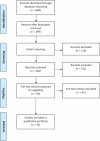Somatic health in the Indigenous Sami population - a systematic review
- PMID: 31262241
- PMCID: PMC6610513
- DOI: 10.1080/22423982.2019.1638195
Somatic health in the Indigenous Sami population - a systematic review
Abstract
The objective of this systematic review was to survey the current scientific knowledge regarding the state of somatic health among situation of the Indigenous Sami people in Norway, Finland, Sweden and the Kola Peninsula in Russia; and assess the quality of the identified studies. A systematic search in the databases Pubmed, EBSCOhost (AMED, Medline, Cinahl) and Svemed was conducted from January 2000, through December 2017. This systematic search identified 399 articles. After screening abstracts, 93 articles were reviewed in full text, 32 of which met the inclusion criteria. The scientific quality of the evidence was rated according to the Newcastle-Ottawa scale. Based on the studies with moderate to high scientific quality, there is evidence for stating that the majority of the Sami included in this review experience good health. Mortality and life expectancy are similar, with only minor differences, to those of a non-Sami population. The cancer risk rate among Sami was lower than that of the general population of Norway, Sweden and Finland. Self-reported myocardial infarction prevalence was similar between Sami and non-Sami, but Angina pectoris was more prevalent among Sami. In Sweden, cardiovascular disease rates were similar between Sami and non-Sami. Musculoskeletal pain symptoms are common among the Sami population, as are obesity and overweight. To conclude, there are knowledge gaps in regard to the somatic health situation of the Indigenous Sami in the circumpolar area, especially in Russia, Finland and Sweden; as current knowledge is mainly based on publications from the SAMINOR study in Norway. No study obtained the highest quality score, suggesting a need to implement longitudinal prospective studies.
Keywords: Indigenous; Newcastle-Ottawa scale; Sami; health; systematic review.
Conflict of interest statement
No potential conflict of interest was reported by the authors.
Figures
References
-
- Stoor JPA. Kunskapssammanställning om samers psykosocial ohälsa. Kiruna: Sametinget. Sverige; 2016. ISBN 978-91-981500-9-4.
-
- Anderson I, Bang A, Bjertness E, et al. Indigenous and tribal peoples’ health - authors’ reply. Lancet. 2016. December 10;388(10062):2868 PubMed PMID: 27979402. - PubMed
-
- Axelsson P. Abandoning “the other”: statistical enumeration of Swedish Sami, 1700 to 1945 and beyond. Ber Wiss. 2010;33(3):263–16. PubMed PMID: 21466142. - PubMed
Publication types
MeSH terms
LinkOut - more resources
Full Text Sources
Miscellaneous


